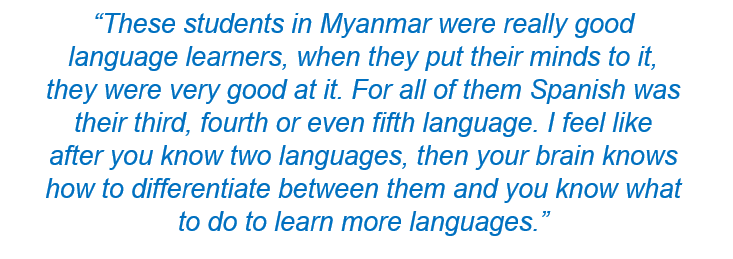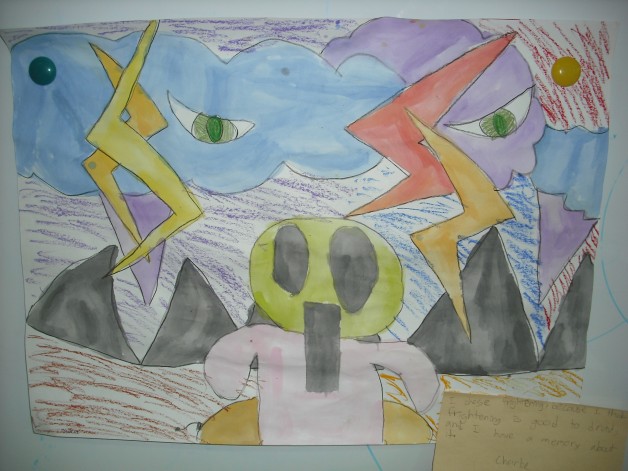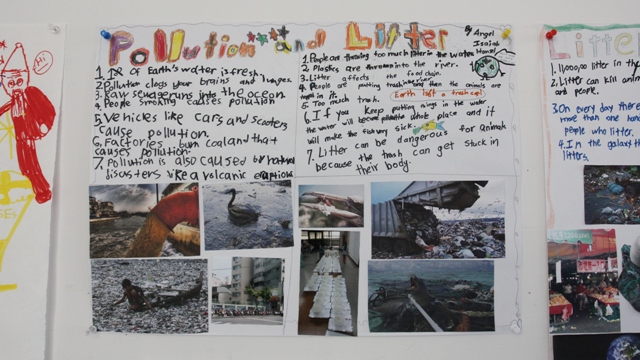
Myanmar, formerly known as Burma, is one of my favorite places in the world across the 57 countries I have visited. Bustling with a diverse ethnic society, you can find people from Bangladesh, Thailand, China and Laos, all neighboring countries, along with the native Burmese. Both names of Myanmar and Burma are translated from Brahma, one of the Hindu gods of the trinity. I felt at peace during my time there and being so in love with Myanmar, I decided to interview an American teacher, Cascade, who has taught there for 3 years.
I met Cascade when I was living in Taiwan, and she was traveling there. We bonded over our love for Myanmar, the Spanish language and the fact that we both are teachers. I have always been interested in teaching in Myanmar so I was curious to hear her story. I find it very interesting how we teachers who decide to move abroad, have such different stories about what drives us to move to the places we choose. We are all connected in a way from our love of learning about the world, and the eagerness to keep moving and exploring different parts of the world. I feel fortunate to be able to keep moving and teaching, and fortunate to meet amazing teachers from all over the world.
Where are you from and where do you live?
I am from USA, but now live in Mexico.
What is your teaching background?
I did a study exchange program in Granada, Spain. Then I majored in Spanish and took some education classes as well. When I finished my students, I went to live in Seville, did my TEFL certification and taught English for 2 years there, from pre-school to adults, all levels of English. After I went to grad school in Seattle and did a masters in Spanish, then I taught Spanish in a middle school and high school there. Then I began thinking about going abroad again so found a job in Yangon, Myanmar, taught Spanish there for 3 years. I also have a yoga teacher training certification, so I have taught yoga as well.
Where have you taught?
USA, Spain and Myanmar.
Why did you join the teaching profession?
I joined the teaching profession because it was a way for me to go to Spain. But even though I joined for a traveling reason, what I realized in Spain is that I really liked teaching and was learning to be good at it. I learned to be able to focus my craft, because when teaching from 3 years old to adult, it is so different. A preschool teacher is different from elementary and high school and adult. So it was good I did those things because it introduced me to different styles of teaching, but also was too much variety, I wanted more focus. For this, I went to grad school and taught college and loved it so then I chose middle school and high school age groups.

Let’s focus in Myanmar, what curriculum did you use there?
Because it was an independent school, and I was the only Spanish teacher, then I was the entire Spanish department. There wasn’t much curriculum in place, so I reorganized the program. I used some textbooks as a syllabus but then I added my own activities and projects.
What did you love about your students in Myanmar?
Generally, they were very curious and very hard working. It was fun for me to have them speak another language, especially because they don’t have a lot of contact with Spanish speakers. Whereas in the States, pretty much people speak some words and understand some of it, Spanish speakers are huge part of our community. Because of this, students see the language as mysterious and intriguing. It was fun to teach them, they were true beginners, so day one I had to teach ‘Hola’ and they had never heard that word before. That was a first for me. You know in the West, Asian culture is exotic and interesting. But living in Asia, the Spanish speaking community of the West is less known to them, so they find that more interesting. Because they get a lot from US through social media, but Spanish is something very different and interesting.
What was unique about your school?
The fact that it was an American curriculum school in Myanmar, it was about 10 years old. The school was all in English, and also had foreign languages such as Spanish and Chinese. 80% were Myanmar students, and next were South Korean, then from all over Asia, Japanese, Thai, Bengali, and Indian. That is also curious because usually when people hear international school they think students are from all over the world. But in this one, they cater more to local population of Asia, so offers US or UK curriculum, with most of our students wishing to go to US high schools and colleges.
What do you find different from education system in Myanmar from USA?
I think there’s a ton of differences when it comes to public education. But between the independent school in Seattle and the international school in Yangon, there are more similarities because they follow independent school model, because they are both private schools. These similarities are: high standards by parents, tuition, college bound demographic. I don’t have experience in public education sector in Myanmar or US really.
Share your favorite memory in teaching in Myanmar
The reason I taught an overload of classes is because after my second year there, the demand for the language grew. The students I had in Spanish level 3, wanted to continue on in Spanish, so it felt like an achievement for me when the school the offered Spanish 4. It felt good to feel like I was creating and building this program there. These students in Myanmar were really good language learners, when they put their minds to it, they were very good at it. For all of them Spanish was their third, fourth or even fifth language. I feel like after you know two languages, then your brain knows how to differentiate between them and you know what to do to learn more languages.
What are you up to now?
Part of independent schooling is usually an annual language trip. In US I remember taking my students to Mexico and Cuba. As a language teacher when you take the students to a country of the language they are learning to speak, it is such an amazing moment, which you cannot create in the classroom. When I was abroad with them it was such a great learning experience. I’ve always been drawn to studying abroad as well. Because if this, when I began thinking a career shift or transition, I wanted to be involved in the student’s experience in studying abroad. Not in the classroom per se. That’s what I’m doing now. I’m a student programs director for Human Connection, a non profit organization that organizes educational trips, and encourage conversations and breaking down stereotypes on both sides of the locals and visitors.
I will be working with students who come here in Mexico to experience the culture. My focus now is responsible tourism. How to be a tourist in a responsible and sustainable way, as far as people are involved and environment. I’m super excited to work with people with amazing vision. It has only been one month now but I love it so far.
Where’s your favorite place on earth?
My favourite is Spain, even though this is hard to answer. Spain was the place I studied abroad by myself, then first placed I lived outside US. For example, during my time of between jobs, I spent 44 days on the Camino de Santiago, which is a pilgrimage from Southern France to Western Spain. It is a historic route to the cathedral of Santiago, where the St James remains are. It is historically a religious pilgrimage, but now people do it for spiritual reasons, cultural reasons or vacation. It is a great lesson in living with less, because you have to carry everything you need on your back. I have written a lot about this in my blog http://cassybeetravel.blogspot.mx/2017/09/day-1-madrid-st-jean-pied-de-port.html
Thank you Cascade for sharing your story.



